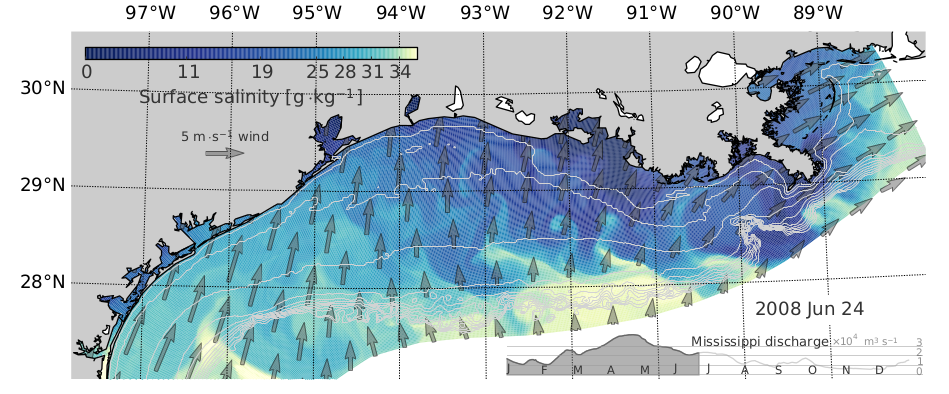

Kristen Thyng
Rob Hetland
The Mississippi river plume is a dynamic feature on the Texas and Louisiana continental shelves, and has a significant impact on the area. Low oxygen conditions periodically occur in the summer, which can be harmful to sealife and may be connected with river-borne nutrients. Additionally, the density gradients introduced by the inflow of fresh water lead to complex circulation patterns.
The fresher river water, shown in blues in the plot, can reach across the shallow continental shelf in large eddies, between about -94 and -90 degrees. These swirling flows can transfer the river water across the shelf break to deeper waters, and bring saltier ocean water (represented in yellower colors) back across the shelf from offshore. The shelf break, where the shelf gets deeper most rapidly, starting around 100 meters depth, acts as a barrier to transport across the shelf. The dynamics that can lead to cross-shelf transport, then, are important for understanding the transport of materials between the near- and far-shore regions. This is particularly significant for understanding the transport of oil from offshore spills toward the coastline.
This figure shows the salinity of the Gulf of Mexico along the Texas and Louisiana shelves at the surface from an ocean circulation model. The colorbar shows the salinity, which uses a basic matplotlib colormap that has been stretched to represent the logarithmic surface area of a river plume – that is, so that more of the range of salinities in the plume is visible in this representation. Grey arrows are overlaid showing the wind, which is another important forcing mechanism. The river discharge for the year of the Mississippi river, the largest in the area, is shown in the bottom right, and is filled up to the date of the figure for context.
Data files omitted by committee due to size constraints